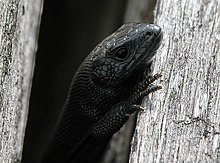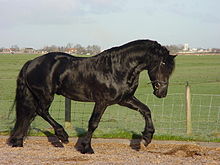Melanism



Under melanism ( gr. "Blackening" of melas "black") are understood in the animal kingdom, a dark pigmentation of u. a. Skin, hair, dandruff from melanins . In addition to genetic causes, this can also have various other reasons such as increased solar radiation, greater humidity, lower temperature and other factors ( modification due to environmental influences ).
Deviation from the norm
In scientific literature as well as in animal breeding, the term "melanism" is often used as excessive pigmentation and thus massive deposition of melanins and deviation from the norm. A melanistic animal (also called a blackened animal) is colored completely black in contrast to the usual coloring of its species . The most famous blacks are the black panthers .
One differentiates:
- Abundism : here new dark drawing elements appear.
- Nigrism : only existing dark drawing elements become larger here.
- Scotasm : here there is complete darkening.
Melanism is not only found in cats in the animal kingdom . It also occurs for example in queues (z. B. viper ), or birds such as Orange-Breasted Waxbill , tiger finch , Ruddy Ground Dove or tape finches on. In birds, however, melanism sometimes seems to be a reaction to stress , an unbalanced diet and lack of light, which can be reversed after the next moult . He is also not inheritable here. In turtles one knows the so-called age melanism, the black coloration in old age of the animal.
Opposite to melanism, albinism and leucism appear , whereby the color pigments in the skin or in the fur are missing for various reasons.
Even the acromelanism , in which only the extremities are dark in color, is a partial melanism.
Genetic bases

Melanism usually results from mutating one of the gene loci responsible for coat patterning. These include the agouti locus (A) and the extension locus (E). Genetically, completely brown or yellow animals without black pigments are the opposite of melanism.
Extension Locus (E)
There is a dominant allele E D of the extension locus (E) which causes the affected animals to become completely dark (melanism) regardless of the agouti locus. The recessive allele e causes the fur on the whole body to turn red-yellow, so that the agoutilocus can no longer produce any black coloring. In between there are some alleles that allow the agouti locus to influence.
Agouti locus (A)
By mutations of the Agouti locus the black areas can be enlarged in the coat pattern ( Nigrismus ) to, in extreme cases, the entire body is black ( Skotasmus ), so it creates "melanism" to varying degrees. Melanism caused by the agoutilocus is inherited recessively.
More gene loci
Since the color genetics of various animal species has not yet been fully researched, it is to be expected that other gene loci can play a role in the development of melanism.
K locus
In the dog, for example, a K locus was detected on the dog chromosome 16 which corresponds neither to the agouti nor to the extension locus and has three known alleles: black (K B )> brindle (k br )> yellow (k y ).
The K locus codes for beta defensin 103 (CBD103). Its gene product binds to the melanocortin receptor 1 , which is encoded by the extension locus and has a strong effect on the switch from eumelanin to pheomelanin.
Examples of black animal genetics in different breeds of domestic animals
The difficulty in explaining melanism is that traditionally only black animals from wild animals have been referred to as melanistic, but that research on how color genetics works has so far mainly been carried out on pets, so that our knowledge of the development of black color mainly relates to domestic animals .
Horse: black
A black horse , i.e. a black horse, differs from a wild-colored horse in the following mutations:
- In the extension locus (E) it has the same dominant allele as a wild horse at least once (EE or Ee) - a horse that is pure breeding for the chestnut color (ee) cannot be darkened to a black horse.
- In the agouti locus (A) it is homozygous for the allele of the gene that spreads eumelanin all over the body. Wild type: AA, Aa looks like wild type, aa is black
- In the Dun-Locus (D) the lightening of the body to a fawn , which is typical for wild-colored horses, is no longer present .
In Arabs there is also a dominant allele for black color, which, however, cannot be assigned to the extension locus.
Black color mice
Black color mice can be created in a number of ways.
- Mutations of the agouti locus : On the one hand there is the recessive mutation "extremely nonagouti" (a e ), which leads to complete black coloration regardless of mutations in the extension locus. There is also the mutation Nonagouti (a), which is also recessive compared to the wild coloring, in which there is even lighter hair behind the ears and around the sexual organs. The gene agouti suppressor A s darkens various alleles to black.
- Mutations of the extension locus : The mutation Extension-Sombre (E so ), if present heterozygous (E so E), leads to mice that cannot be distinguished from homozygous (aa) of the mutation Nonagouti (a). If the allele is homozygous (E so E so ), the mice are completely black. Another darkening gene is the allele "Tobacco Darkening" (E tob ).
Black dogs
In domestic dogs, there is a gene for dominant black color on the K locus, which is on the dog chromosome 16, which is abbreviated to K B. For the affected dogs to be black, it is sufficient if the K B allele occurs only once. So the genotypes K B K B , K B k br and K B k y lead to black coloration. It occurs in black Labrador retrievers, black poodles, and Newfoundlands, among others. The dominantly inherited black coat color in North American wolves was created by crossing black dogs around 10,000 - 15,000 years ago.
There is also an allele for recessive black color (a) on the agouti locus. The affected animals are only black if the agoutilocus allele a is present on both chromosomes, i.e. aa. The gene is epistatic to the K locus, that is, animals with the combination aa on the agoutilocus always remain black regardless of the K locus.
The recessive yellow (e) allele of the extension locus brightens both types of black coloration to a light red gold. It occurs in the Labrador Retriever, Irish Setter and Samoyedian. That being said, both genes for black staining can darken all alleles of the extension locus to black.
See also
Individual evidence
- ↑ a b melanism. In: Herder-Lexikon der Biologie. Spektrum Akademischer Verlag, Heidelberg 2003, ISBN 3-8274-0354-5 .
- ↑ a b c Krista Siebel: Analysis of genetic variants of loci for the coat color and their relationships to the color phenotype and to quantitative performance characteristics in pigs. Inaugural Dissertation for the Degree of Doctor of Veterinary Medicine; Institute for Animal Science at the Humboldt University in Berlin. July 2001.
- ↑ a b c d Julie A. Kerns et al: Linkage and segregation analysis of black and brindle coat color in domestic dogs. In: Genetics. 2007 Jul; 176 (3) Epub 2007 May 4, PMID 17483404 , pp. 1679-1689.
- ↑ a b Julie A. Kerns et al .: Exclusion of melanocortin-1 receptor (mc1r) and agouti as candidates for dominant black in dogs. In: J Hered. 2003 Jan-Feb; 94 (1), PMID 12692166 , pp. 75-79.
- ↑ Sophie I. Candille include: A β-defensin mutation causes black coat color in domestic dogs. In: Science. 2007 Nov 30; 318 (5855), Epub 2007 Oct 18. PMID 17947548 , pp. 1418-1423.
- ↑ a b Willys K. Silvers: The Coat Colors of Mice. Springer-Verlag, New York / Heidelberg / Berlin 1979, ISBN 3-540-90367-4 .
- ↑ [1]


